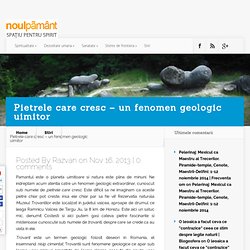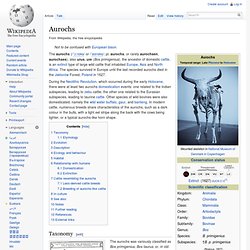

Malus P. Mill. - Checklist View. Common names: Camelus ferus; Wild Camel; Wild Bactrian Camel (Camels (Artiodactyla Camelidae) > Camelus bactrianus) Taxonomic status Scientific name Camelus bactrianus Common name Bactrian Camel Synonyms Camelus ferus; Wild Camel; Wild Bactrian Camel Go back up Species information Physical characteristics This species has a long wooly coat, which varies in colour from dark brown to sandy beige.

Bactrian Camel, Great Gobi A Habitat, behaviour, food and reproduction Habitat and food This species is found in the Gobi and Gashun Gobi deserts of northwest China and Mongolia. Behaviour Bactrian camels are extremely adept at withstanding wide variations in temperature - from the freezing cold to the blistering heat. Bactrian camels are said to be good swimmers. Wild camel in Lop Nur wild camel nature reserve Reproduction and group structure.
Pietrele care cresc - un fenomen geologic uimitor. Pamantul este o planeta uimitoare si natura este plina de minuni.

Ne indreptam acum atentia catre un fenomen geologic extraordinar, cunoscut sub numele de pietrele care cresc. Este dificil sa ne imaginam ca aceste pietre chiar pot creste, insa ele chiar par sa fie vii! Rezervatia naturala Muzeul Trovantilor este localizat in judetul valcea, aproape de drumul ce leaga Ramnicu Valcea de Targu Jiu, la 8 km de Horezu. Este aici un satuc mic, denumit Costesti si aici putem gasi cateva pietre fascinante si misterioase cunoscute sub numele de trovanti, despre care se crede ca au viata in ele. Trovant este un termen geologic folosit deseori in Romania, el insemnand nisip cimentat.
Cutremurul care se crede ca a creat primii trovanti a avut loc acum 6 milioane de ani. Trovantii din Romania. Pinterest. Descoperire: cel mai înalt brad din România. EXCLUSIV.

Un grup de cercetători români a descoperit un brad înalt cât un bloc de 23 de etaje în pădurea Șinca Veche, de lângă Brașov. Cercetătorul în silvicultură Cătălin Roibu și echipa sa au trăit unul dintre cele mai frumoase momente din carieră. Zilele trecute, în timpul studiilor pe care specialiștii le fac la rezervația naturală de la Șinca Veche au descoperit cel mai înalt brad din România măsurat până acum. „Am descoperit un brad de 62,5 metri înălțime. În momentul de față vorbim de un record. Și fagul are înălțime foarte mari, de peste 56 de metri. Echipa de specialiști în silvicultură de la Facultatea din Suceava cercetează la Şinca Veche dinamica pădurii naturale virgine, un amestec de brad cu fag. De altfel, cei de la WWF au făcut toate demersurile pentru ca pădurea de la Şinca Veche să rămână „un colţ de rai, cvasivirgin, care a cunoscut prea puțin influența omului” .
„Pădurile seculare ale României rămân un tezaur necunoscut pentru mulți dintre noi. 7 Demonic Creatures: Thorny Devil, Satanic Gecko, More. For some diabolical-looking animals, “you look like hell” may not be so much of an insult.

From birds to beetles to snakes, nature has a lot of devilishly creepy creatures—including the recently discovered “demon” ants named for gods of the Maya underworld. Here’s a roundup of animals that would likely be favorite pets of Gomez and Morticia. Satanic Leaf-Tailed Gecko With its piercing red eyes, tiny horns, and sinister smile, the satanic leaf-tailed gecko probably wouldn’t be a good mascot for anything but brimstone … except perhaps mimicry. The smallest member of the Uroplatus, or leaf-tailed gecko family, Uroplatus phantasticus blends in seamlessly in its Madagascar forest habitat. A satanic leaf-tailed gecko clings to a twig in Madagascar. That didn’t stop it from getting discovered and becoming wildly popular as a pet.
Also in 2011, a satanic leaf-tailed gecko had the honor of being the first baby born at the San Diego Zoo that year. That number was not 666. Anglerfish Thorny Devil. Aurochs. The aurochs (/ˈɔːrɒks/ or /ˈaʊrɒks/; pl. aurochs, or rarely aurochsen, aurochses), also urus, ure (Bos primigenius), the ancestor of domestic cattle, is an extinct type of large wild cattle that inhabited Europe, Asia and North Africa.

The species survived in Europe until the last recorded aurochs died in the Jaktorów Forest, Poland in 1627. During the Neolithic Revolution, which occurred during the early Holocene, there were at least two aurochs domestication events: one related to the Indian subspecies, leading to zebu cattle; the other one related to the Eurasian subspecies, leading to taurine cattle. Other species of wild bovines were also domesticated, namely the wild water buffalo, gaur, and banteng. In modern cattle, numerous breeds share characteristics of the aurochs, such as a dark colour in the bulls, with a light eel stripe along the back with the cows being lighter, or a typical aurochs-like horn shape.
Taxonomy[edit] Etymology[edit] Evolution[edit] Description[edit]